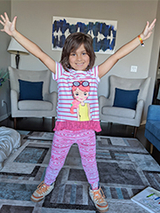Siena’s Story: Fetal Surgery for Myelomeningocele
Siena’s Story: Fetal Surgery for Myelomeningocele
A life-altering experience — and life-changing care — at Children’s Hospital of Philadelphia’s Richard D. Wood Jr. Center for Fetal Diagnosis and Treatment inspired Siena’s family to ease the burden for others.

During a 20-week ultrasound, Meagan and Nathan’s child, Siena, was prenatally diagnosed with myelomeningocele (MMC), the most severe form of spina bifida, a condition in which an area of the spinal column doesn’t form properly, leaving a section of the spinal cord and nerves exposed through an opening in the back, which can cause progressive neurologic injury.
As the obstetrician (OB) described the diagnosis and the couple’s options for the pregnancy, Meagan recalled a video she’d seen in high school health class about fetal surgery to treat MMC. Meagan asked the OB if fetal surgery was an option.
Benefits of Fetal Surgery for Spina Bifida Persist in School-Age Children
That question led to a consultation with Robert Douglas Wilson, MD, MSc, Head of the Department of Obstetrics and Gynaecology at the University of Calgary, near the family’s residence in Alberta, Canada. Dr. Wilson had been part of the CHOP team that laid the groundwork for fetal surgery for MMC in the 1990s, led by N. Scott Adzick, MD, founder and director of the Richard D. Wood Jr. Center for Fetal Diagnosis and Treatment (CFDT) at Children’s Hospital of Philadelphia (CHOP).
After reviewing the fetal imaging — which showed evidence of the Chiari malformation as well as hindbrain herniation, which can cause hydrocephalus, or fluid accumulation in the brain — Dr. Wilson discussed the possible prognosis after birth and statistics about fetal surgery.
Prenatal closure can significantly reduce neurological damage and the need for shunting, reverse hindbrain herniation, and improve mobility.
Journey to CHOP for hope

Meagan and Nathan flew from Calgary to Philadelphia at 25 weeks’ gestation. When they arrived at CHOP, they met Senior Genetic Counselor/Fetal Therapy Coordinator, Stefanie Kasperski, MS, CGC, who helped them navigate their two day evaluation which included meetings with specialists in fetal imaging and maternal-fetal medicine, as well as a team of fetal surgeons and neurosurgeons with the world’s greatest experience in fetal surgery for MMC.
“The team was really exceptional,” says Meagan. “Each person took time to meet with us. They really cared about how we were handling all the information and the situation, and they really wanted to make sure that we were emotionally OK and had support.”
In addition to the potential impact of fetal closure on the Chiari malformation and hindbrain herniation, the CHOP team noted the baby’s ventricles were so large that without fetal intervention she would likely need a shunt after birth.
“I was sold on the surgery,” says Meagan. “I knew it would help her quality of life.”
Life-changing fetal surgery for MMC

Just two days after the evaluation, Meagan underwent fetal MMC closure. Post-procedure, she needed to stay in Philadelphia for a minimum of four weeks for close monitoring. Meagan’s sister and mother were nothing short of superheroes: They not only took turns looking after the couples’ two young children ages 3 and 18 months but also helped relieve Nathan as Meagan’s support person in Philadelphia.
Meagan had planned to stay at a hotel during her month-long stay in Philadelphia, a financial expense her family could barely afford. Fortunately, on the day she was discharged from the hospital, a room became available at the Ronald McDonald House, a home away from home for families traveling to receive care at CHOP, offering lodging and meals at a significantly lower cost. The Canadian government also helped ease the financial burden with support for medical bills and travel costs.
It was a hectic month for everyone in the family, but it was worth it. At Meagan’s first follow-up appointment at the CFDT one week after her fetal surgery, the Chiari malformation had already begun reversing and the ventricles in the baby’s brain were stabilizing. By the second week post-op, the Chiari malformation had reversed completely, which protects the developing brain and reduces the need for a shunt down the road.
After a month of weekly follow-up appointments, with everything looking good, Meagan was able to return home to Canada with her mother. She was followed closely at the University of Calgary for the remainder of her pregnancy and delivered via C- Section at 36 weeks gestation.
Making many dreams come true

Siena, now 7 years old, is in first grade and is learning wonderfully, says her mom. She hasn’t needed a shunt.
“She was a happy baby, always smiling and giggling, and now she’s just a lovely girl,” says Meagan.
Siena could crawl at age 1 and walk at age 2, and she hasn’t stopped being on the move since. She has a bit of imbalance when she walks, runs and jumps, so she wears ankle-foot orthoses (AFOs). She also has a routine in place for management of her bowels and bladder. A spina bifida clinic near her home in Canada has managed her care since birth.
As a child, Meagan was struck by a story about a philanthropist who paid a stranger’s hospital bill. Growing up, she always hoped one day she’d be able to bless someone’s life in a similar way.
As she reflected back on her time at CHOP, Meaghan realized how vital it was to have the emotional support of her family and the financial support of her government. She knows many families don’t have that level of support and saw an opportunity to fulfill her childhood dream of giving a life-changing gift.
In 2022, she reached out to the CHOP Foundation team and donated to a fund that helps cover the costs of travel for families in need of care at the CFDT. With that gift, her childhood dream has come true, and she’s helped fulfill the hopes and dreams of countless families.